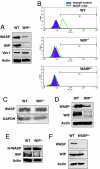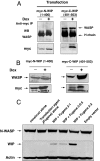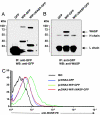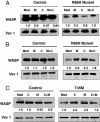WIP is a chaperone for Wiskott-Aldrich syndrome protein (WASP)
- PMID: 17213309
- PMCID: PMC1783416
- DOI: 10.1073/pnas.0610275104
WIP is a chaperone for Wiskott-Aldrich syndrome protein (WASP)
Abstract
Wiskott-Aldrich syndrome protein (WASP) is in a complex with WASP-interacting protein (WIP). WASP levels, but not mRNA levels, were severely diminished in T cells from WIP(-/-) mice and were increased by introduction of WIP in these cells. The WASP binding domain of WIP was shown to protect WASP from degradation by calpain in vitro. Treatment with the proteasome inhibitors MG132 and bortezomib increased WASP levels in T cells from WIP(-/-) mice and in T and B lymphocytes from two WAS patients with missense mutations (R86H and T45M) that disrupt WIP binding. The calpain inhibitor calpeptin increased WASP levels in activated T and B cells from the WASP patients, but not in primary T cells from the patients or from WIP(-/-) mice. Despite its ability to increase WASP levels proteasome inhibition did not correct the impaired IL-2 gene expression and low F-actin content in T cells from the R86H WAS patient. These results demonstrate that WIP stabilizes WASP and suggest that it may also be important for its function.
Conflict of interest statement
The authors declare no conflict of interest.
Figures






Similar articles
-
A peptide derived from the Wiskott-Aldrich syndrome (WAS) protein-interacting protein (WIP) restores WAS protein level and actin cytoskeleton reorganization in lymphocytes from patients with WAS mutations that disrupt WIP binding.J Allergy Clin Immunol. 2011 Apr;127(4):998-1005.e1-2. doi: 10.1016/j.jaci.2011.01.015. Epub 2011 Mar 3. J Allergy Clin Immunol. 2011. PMID: 21376381 Free PMC article.
-
T-cell receptor ligation causes Wiskott-Aldrich syndrome protein degradation and F-actin assembly downregulation.J Allergy Clin Immunol. 2013 Sep;132(3):648-655.e1. doi: 10.1016/j.jaci.2013.03.046. Epub 2013 May 16. J Allergy Clin Immunol. 2013. PMID: 23684068
-
WIP, a protein associated with wiskott-aldrich syndrome protein, induces actin polymerization and redistribution in lymphoid cells.Proc Natl Acad Sci U S A. 1997 Dec 23;94(26):14671-6. doi: 10.1073/pnas.94.26.14671. Proc Natl Acad Sci U S A. 1997. PMID: 9405671 Free PMC article.
-
WASP-WIP complex in the molecular pathogenesis of Wiskott-Aldrich syndrome.Pediatr Int. 2016 Jan;58(1):4-7. doi: 10.1111/ped.12819. Epub 2015 Dec 5. Pediatr Int. 2016. PMID: 26331277 Review.
-
Recent advances in the biology of WASP and WIP.Immunol Res. 2009;44(1-3):99-111. doi: 10.1007/s12026-008-8086-1. Immunol Res. 2009. PMID: 19018480 Review.
Cited by
-
Epigenetically upregulated WIPF1 plays a major role in BRAF V600E-promoted papillary thyroid cancer aggressiveness.Oncotarget. 2017 Jan 3;8(1):900-914. doi: 10.18632/oncotarget.13400. Oncotarget. 2017. PMID: 27863429 Free PMC article.
-
Hematopoietic cell transplantation for Wiskott-Aldrich syndrome: advances in biology and future directions for treatment.Immunol Allergy Clin North Am. 2010 May;30(2):179-94. doi: 10.1016/j.iac.2010.02.001. Immunol Allergy Clin North Am. 2010. PMID: 20493395 Free PMC article. Review.
-
NPM-ALK phosphorylates WASp Y102 and contributes to oncogenesis of anaplastic large cell lymphoma.Oncogene. 2017 Apr;36(15):2085-2094. doi: 10.1038/onc.2016.366. Epub 2016 Oct 3. Oncogene. 2017. PMID: 27694894
-
Platelet-associated IgAs and impaired GPVI responses in platelets lacking WIP.Blood. 2009 Nov 19;114(21):4729-37. doi: 10.1182/blood-2009-02-202721. Epub 2009 Aug 19. Blood. 2009. PMID: 19692704 Free PMC article.
-
Proteasome Dependent Actin Remodeling Facilitates Antigen Extraction at the Immune Synapse of B Cells.Front Immunol. 2019 Feb 19;10:225. doi: 10.3389/fimmu.2019.00225. eCollection 2019. Front Immunol. 2019. PMID: 30873155 Free PMC article.
References
-
- Derry JMJ, Ochs HD, Francke U. Cell. 1994;78:635–644. - PubMed
-
- Cannon JL, Labno CM, Bosco G, Seth A, McGavin MH, Siminovitch KA, Rosen MK, Burkhardt JK. Immunity. 2001;15:249–259. - PubMed
-
- Sasahara Y, Rachid R, Byrne MJ, de la Fuente MA, Abraham RT, Ramesh N, Geha RS. Mol Cell. 2002;10:1269–1281. - PubMed
Publication types
MeSH terms
Substances
Grants and funding
LinkOut - more resources
Full Text Sources
Molecular Biology Databases

